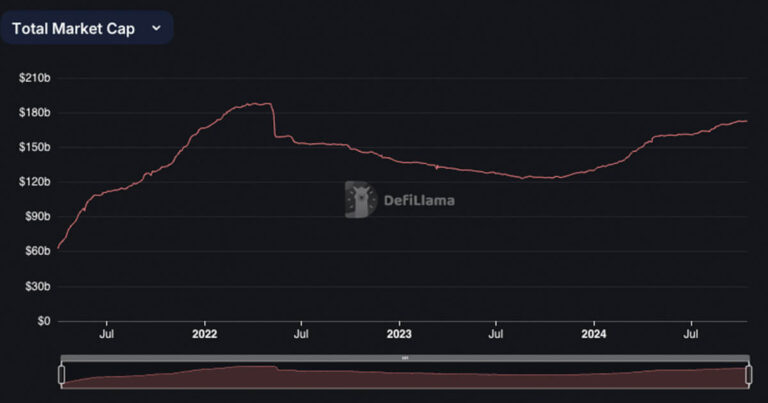Stablecoin market capitalization has trended across multiple blockchains over the past week. The total market capitalization of all chains has reached $172 billion, just $15 billion away from the all-time high of $187 billion set in 2022. After UST’s bankruptcy, its total market capitalization fell to $157 billion.
Stablecoin market capitalization | Source: Defilama
According to DefiLama, the Ethereum stablecoin limit increased by 0.69% to $84.869 billion, with USDT accounting for 55.49% of the stablecoin dominance. TRON increased by 0.39% to $60.184 billion, with USDT accounting for 98.26%.
Distribution of stablecoins across chains | Source: Defilama
The stablecoin limit on Binance Smart Chain increased by 0.34% to $5.014 billion, with USDT accounting for 79.39%. Arbitrum experienced a slight decrease of 0.67%, with a stablecoin cap of $4.433 billion, with USDT accounting for 63.67%. Base’s stablecoin cap increased by 0.97% to $3.758 billion, the majority of which was USDC at 92.69%.
Solana faces a 3.30% decline in its stablecoin cap, currently at $3.607 billion, with USDC accounting for 66.35%. Avalanche saw a significant increase of 4.60% to $2.39 billion, with USDT accounting for 65.43%. Polygon’s stablecoin cap increased by 2.15% to $1.928 billion, with USDC holding a 52.30% lead.
Optimism’s stablecoin cap decreased by 5.32% to $1,142 million, while Nia saw a modest increase of 0.17% to $669.38 million. Aptos recorded a notable increase of 9.35% to $254.54 million, with USDC accounting for 58.75%.
These changes indicate changing trends in interchain stablecoin circulation. Factors such as the total market capitalization and bridged assets issued on-chain and the stablecoin market capitalization to total value locked (TVL) ratio highlight liquidity dynamics and user preferences. .
Stablecoin issuance and bridge assets
In stablecoin issuance across blockchains, subtle trends are also revealed when comparing the market capitalization of on-chain issuance to the total market capitalization of bridged assets. On Ethereum, a net $95.4 billion of stablecoins have been issued directly on-chain, while only $5.69 million have been bridged, reinforcing Ethereum’s role as a major hub for stablecoin liquidity. It is emphasized. The stablecoin to TVL ratio is 1.9, reflecting the balanced integration of stablecoins into DeFi infrastructure.
In contrast, Tron is highly dependent on stablecoins, with $62.36 billion issued and no significant bridge assets, resulting in a high stablecoin-to-TVL ratio of 8.28. Tron’s focus on efficient stablecoin transactions, specifically USDT, indicates that there are more stablecoin-centric use cases on the network.
Avalanche has $2.3 billion of stablecoins issued on-chain and $94.98 million of bridged stablecoins, increasing its stablecoin market capitalization. The stablecoin to TVL ratio of 2.4 reflects a moderate reliance on stablecoins within the DeFi ecosystem. Solana, on the other hand, has a significantly lower ratio of 0.69 despite having a stablecoin market cap of $3.6 billion and $9.21 million bridged, indicating a decline in stablecoin activity in its DeFi environment. It shows that.
With $3.76 billion in stablecoins and $134.99 million bridged, the stablecoin-to-TVL ratio is 1.67, suggesting a steady increase in usage. In contrast, Optimism has a higher ratio of 1.82 despite its stablecoin cap of $1.142 billion, making it one of the largest stablecoins in the ecosystem despite its recent decline in market capitalization. This shows that the relative presence of


